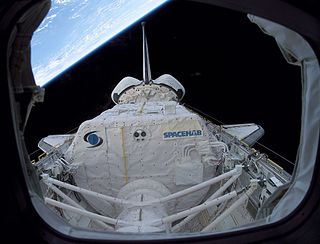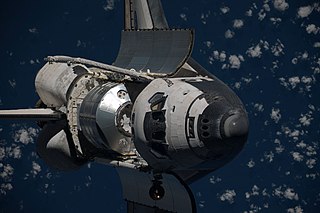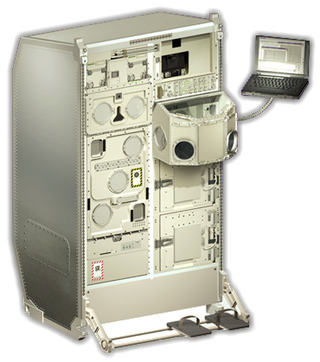Related Research Articles

STS-107 was the 113th flight of the Space Shuttle program, and the 28th flight of Space Shuttle Columbia. The mission ended, on February 1, 2003, with the Space Shuttle Columbia disaster which killed all seven crew members and destroyed the space shuttle. It was the 88th post-Challenger disaster mission.

Columbus is a science laboratory that is part of the International Space Station (ISS) and is the largest single contribution to the ISS made by the European Space Agency (ESA).

STS-65 was a Space Shuttle program mission of Columbia launched from Kennedy Space Center, Florida, 8 July 1994. The commander of this flight was Robert D. Cabana who would go on later to lead the Kennedy Space Center.

STS-76 was NASA's 76th Space Shuttle mission, and the 16th mission for Atlantis. STS-76 launched on 22 March 1996 at 08:13:04 UTC from Kennedy Space Center, launch pad 39B. STS-76 lasted over 9 days, traveled about 6,100,000 km (3,800,000 mi) while orbiting Earth an estimated 145 times, and landing at 13:28:57 UTC on 31 March 1996 at Edwards Air Force Base, runway 22.

STS-91 was the final Space Shuttle mission to the Mir space station. It was flown by Space Shuttle Discovery, and launched from Kennedy Space Center, Florida, on 2 June 1998.

STS-105 was a mission of the Space Shuttle Discovery to the International Space Station, launched from Kennedy Space Center, Florida, 10 August 2001. This mission was Discovery's final mission until STS-114, because Discovery was grounded for a refit, and then all Shuttles were grounded in the wake of the Columbia disaster. The refit included an update of the flight deck to the glass cockpit layout, which was already installed on Atlantis and Columbia.

STS-121 was a 2006 NASA Space Shuttle mission to the International Space Station (ISS) flown by Space ShuttleDiscovery. The main purposes of the mission were to test new safety and repair techniques introduced following the Columbia disaster of February 2003 as well as to deliver supplies, equipment and German European Space Agency (ESA) astronaut Thomas Reiter to the ISS.

The Destiny module, also known as the U.S. Lab, is the primary operating facility for U.S. research payloads aboard the International Space Station (ISS). It was berthed to the Unity module and activated over a period of five days in February, 2001. Destiny is NASA's first permanent operating orbital research station since Skylab was vacated in February 1974.

The International Standard Payload Rack (ISPR) is a steel framework container that is designed and been adopted by the International Space Station (ISS) program to support efficient integration and interchangeability of space payload hardware, such as machines and experiments. A typical rack contains 37 ISPR slots for science payloads, which are interchangeable to accommodate different components or payloads.

The Minus Eighty-Degree Laboratory Freezer for ISS (MELFI) is a European-built experiment storage freezer for the International Space Station. It comprises four independent dewars which can be set to operate at different temperatures. Currently temperatures of −80 °C, −26 °C, and +4 °C are used during on-orbit ISS operations. Both reagents and samples will be stored in the freezer. As well as storage the freezer is designed to be used to transport samples to and from the ISS in a temperature controlled environment. The total capacity of the unit is 300 litres.

STS-128 was a NASA Space Shuttle mission to the International Space Station (ISS) that launched on August 28, 2009. Space ShuttleDiscovery carried the Multi-Purpose Logistics Module Leonardo as its primary payload. Leonardo contained a collection of experiments for studying the physics and chemistry of microgravity. Three spacewalks were carried out during the mission, which removed and replaced a materials processing experiment outside ESA's Columbus module, and returned an empty ammonia tank assembly.

Biolab is a single-rack multi-user science payload designed for use in the Columbus laboratory of the International Space Station. Biolab support biological research on small plants, small invertebrates, microorganisms, animal cells, and tissue cultures. It includes an incubator equipped with centrifuges in which the preceding experimental subjects can be subjected to controlled levels of accelerations.

STS-135 was the 135th and final mission of the American Space Shuttle program. It used the orbiter Atlantis and hardware originally processed for the STS-335 contingency mission, which was not flown. STS-135 launched on July 8, 2011, and landed on July 21, 2011, following a one-day mission extension. The four-person crew was the smallest of any shuttle mission since STS-6 in April 1983. The mission's primary cargo was the Multi-Purpose Logistics Module (MPLM) Raffaello and a Lightweight Multi-Purpose Carrier (LMC), which were delivered to the International Space Station (ISS). The flight of Raffaello marked the only time that Atlantis carried an MPLM.

The Materials Science Laboratory (MSL) of the European Space Agency is a payload on board the International Space Station for materials science experiments in low gravity.

The International Space Station is a platform for scientific research that requires one or more of the unusual conditions present in low Earth orbit. The primary fields of research include human research, space medicine, life sciences, physical sciences, astronomy and meteorology. The 2005 NASA Authorization Act designated the American segment of the International Space Station as a national laboratory with the goal of increasing the use of the ISS by other federal agencies and the private sector.

The European Drawer Rack (EDR) is a single, six-post International Standard Payload Rack (ISPR) with seven Experiment Modules (EMs), each of which has separate access to power and cooling. A video management unit sends streaming video, images, and science data to Earth via the Columbus module's high-rate data link and can temporarily store 72 GB of video. The experiments are largely autonomous to minimize data transfer requirements, though the EDR can be operated remotely via telescience or in real time by the crew via a dedicated laptop. The EDR has two different types of EMs: the standard International Space Station locker and the standard eight panel unit International Subrack Interface Standard (ISIS) drawer.

Human Research Facility 1 (HRF-1) on board the International Space Station (ISS) allows investigators to study the effects of long-duration space flight on the human body. Equipment in the HRF-1 includes a clinical ultrasound and a device for measuring mass.
Microgravity Experiment Research Locker/Incubator (MERLIN) was designed by University of Alabama at Birmingham (UAB) Center for Biophysical Sciences and Engineering (CBSE) to operate as a hardmounted, single middeck locker equivalent within the ISS EXPRESS rack, the Space Shuttle, SpaceX Dragon, and Cygnus (spacecraft). It is used to provide a temperature controlled environment for scientific experiments between -20 °C and 48.5 °C. MERLIN is also used to Support Crew Galley Operations.
Polar is a research refrigerator designed and developed by University of Alabama at Birmingham (UAB) Center for Biophysical Sciences and Engineering (CBSE) for NASA Cold Stowage. Polar was designed as a single mid-deck locker equivalent payload to store scientific samples on-board ISS and in transport to/from ISS via SpaceX Dragon or Cygnus spacecraft. Polar operates between 4 to −95 °C.

SpaceX CRS-24, also known as SpX-24, was a Commercial Resupply Service mission to the International Space Station launched on 21 December 2021, at 10:07:08 UTC. The mission is contracted by NASA and is flown by SpaceX using a Cargo Dragon. This is the fourth flight for SpaceX under NASA's CRS Phase 2 contract awarded in January 2016.
References
- ↑ "Fact Sheet". NASA. Archived from the original on 25 November 2010. Retrieved 14 January 2015.
- ↑ "News Archive | UAB".
- ↑ NASA.gov
- ↑ "Hacker News comment from engineer who worked on GLACIER". news.ycombinator.com. Retrieved 2018-05-19.
- ↑ "GLACIER". UAB CBSE. Archived from the original on 4 January 2015. Retrieved 14 January 2015.
- ↑ NASA.gov